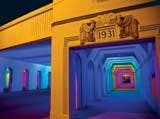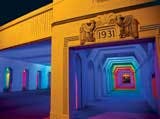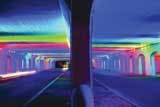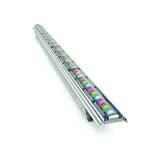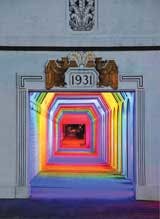Birmingham celebrates railroad history, connects city center with LEDs (MAGAZINE)
+++++
This article was published in the October 2013 issue of LEDs Magazine.
Visit the Table of Contents and view the E-zine version in your browser. You can download a PDF of the magazine from within the browser E-zine.
+++++
Most major industrial cities in the US are situated on navigable bodies of water, points out Atticus Rominger, chief public and investor relations officer at the REV Birmingham organization charged with revitalizing the Birmingham, Alabama downtown area and neighborhoods. For Birmingham, it was the major railway line that split the city — running predominantly east and west — and enabled the city to become a 20th-century industrial and transportation center and a leader in iron and steel manufacturing. While much of the heavy industry is gone, Birmingham has chosen to celebrate its history as a major railway hub and has built a spectacular urban park and minor-league baseball stadium called Regions Field on the south side of the tracks. Now an LED light sculpture by Bill FitzGibbons called LightRails has turned the city's 18th Street railway underpass into a dynamic interconnect between the revitalized south side and city center to the north (Fig. 1).
Like many cities caught in a transition away from heavy industry, Birmingham has been through a period where many of its residents avoided the downtown and other downtrodden areas. Over the course of the past few decades, the city has strived to encourage development downtown; indeed, the city center area has attracted restaurants and entertainment venues along with increased occupancy in office space.
The south side of the tracks, however, has fared more poorly. Rominger said that the railway underpasses, while lit with functional white light, had become home to vagrants and that residents or visitors were hesitant to walk through the pedestrian passages located adjacent to roadway tunnels.
Still, Rominger said, "Rather than hide it, Birmingham decided to highlight the railroads," given the important role the lines played in the city's history. Moreover, in the downtown area the four underpasses were constructed in the 1930s with Art Deco style. In 2010, the city opened the new urban park called Railroad Park that lies parallel to the tracks between 14th and 18th Streets, across the railroad from city center. The park includes nine acres of open lawn along with lakes and recreational facilities, and serves as a concert and entertainment venue.
Connecting the districts
Despite the popularity of the park and the presence of state-of-the-art security, there was still little movement of visitors between the park and nearby city center. Soon, however, the baseball stadium would add to the story. The city had planned to open Regions Field across from the southwest corner of Railroad Park in April 2013. Rominger said that REV Birmingham and the city realized in mid-2012 that it needed to better connect the park and baseball district with city center.
And in spite of the fact that the city has had financial struggles at times, there is a local organization called the Community Foundation of Greater Birmingham that establishes Community Catalyst Funds allowing local philanthropists to donate money to help drive transformational change in the city. Funds from that source allowed REV Birmingham to move relatively quickly on what was an expensive proposition up front — installing color-changing LEDs and a control system.
Through contacts with the local arts district, REV Birmingham met light sculptor Bill FitzGibbons, who had previously used color LED lighting under freeway underpasses in his hometown of San Antonio, Texas. REV Birmingham first discussed the project with Fitzgibbons in November 2012, yet he wouldn't visit the site until March 2013. But REV Birmingham wanted the project lit during the 2013 baseball season. Rominger said the philosophy was "Let's not walk, let's run," speaking for the project backers.
Opportunities and obstacles
When FitzGibbons saw the project site, he immediate recognized the potential for the light sculpture based on the architectural style — especially in the pedestrian walkways that included beams and arches (Fig. 2). FitzGibbons said, "If I were to design an underpass for an LED art installation, this is the type of design I would implement."
The desired schedule of course was a problem. But FitzGibbons had prior experience using Philips Color Kinetics color-tunable luminaires and controllers in such projects, and the company had the required products available with relatively short lead times or from stock.
In many municipal projects, multiple levels of government can also delay projects. In Birmingham, the city was behind the project. The railroads own the bridges, but the city is charged with maintenance and FitzGibbons said the railroads took a hands-off approach to the project. So LightRails progressed much more quickly than many projects.
Electrical service was also a non-issue in the LightRails project. The city had installed new white lighting in the underpasses within the past decade. While the lighting itself had not been well maintained, the electrical service was more than sufficient to power the new lighting. FitzGibbons said that his team had to install a new NEMA box to house the lighting controller and run some new conduit and wiring to the fixture locations.
RGB fixtures and controller
Ultimately, FitzGibbons specified around 100 luminaires for the project including a mix of ColorGraze MX Powercore (Fig. 3), ColorBlast Powercore, and ColorBurst Compact Powercore fixtures. All of the products are based on red, green, and blue (RGB) LEDs. A Philips Color Kinetics iPlayer3 Controller links to all of the fixtures. Jeff Campbell, product manager at Philips Color Kinetics, said that the installation uses four-conductor cables that distribute both power and control signals to the luminaires using a DMX network.
The design uses linear 2- and 4-ft ColorGraze fixtures to graze the surfaces. The rectangular ColorBlast fixtures are used for wall washing and floodlighting. And the smaller round ColorBurst Compact fixtures add accent lighting. All work in concert to provide effects ranging from static color spectra to dynamic changing colors and effects.
FitzGibbons programmed the system to play a 17-minute program that loops each night from dusk to dawn. The installation provides the requisite level of white light during the day. FitzGibbons described some of the effects as using colors with white sparkles and using "color as a column to explore the architectural space." Especially in the smaller pedestrian tunnel, a single fixture can generate a reflection 360° around the tunnel. FitzGibbons added that in the pedestrian tunnel, "The beams and arches provide additional opportunities to show the spectrum."
The installation also provides the opportunity for special shows. For example, FitzGibbons said he has already programmed the iPlayer3 to switch automatically to a holiday presentation in December with an emphasis on red and green colors. Philips' Campbell said that the controller could store even more programs that can be triggered by an astronomical clock. New programs can be downloaded via an SD card.
June LightRails debut
Despite the compressed schedule, Birmingham and FitzGibbons lit the LightRails project on June 27, 2013, allowing baseball fans and park users to make a safe and enjoyable walk between what is being called the parks district and city center (Fig. 4).
But LightRails has done far more. Rominger said the situation has changed from one of "trying to get people to walk through the underpass" to one where "people come downtown just to see the lights." FitzGibbons isn't surprised and added, "It's the power of what contemporary light sculpture can do." An uninviting underpass has become a place people want to visit. About such public projects, FitzGibbons said, "They are transformative for urban areas."
Not only has LightRails brought visitors to the downtown area, it has helped the city mitigate some of its vagrancy issues. With more people in the area and the improved lighting, the vagrants quickly disappeared from the area.
Operational costs and light spill
While LightRails has been a clear success early on, we wondered about potential ongoing concerns about excessive use of electricity or light pollution. About the electrical cost, FitzGibbons said that the color lighting installation was designed to use one-third of the energy of the prior white lights. Rominger said the city hasn't measured energy usage as yet, but he doesn't foresee a problem given that the project uses efficient LED sources. Philips Campbell added that 30W to 50W Color Kinetics fixtures regularly replace 100W white lights that use legacy sources.
As for light spill, the LEDs also are directional and mainly focused on surfaces in the tunnel. The installation neither spills light nor distracts drivers, according to Rominger and FitzGibbons. Rominger said, "We have not had a single comment about it that was negative."
Birmingham is now looking for funds and ideas for the three other underpasses in the immediate area of Railroad Park. Regions Field was a blockbuster success in its first baseball season with an architecture modeled after the historic Sloss Furnaces company from Birmingham's past. LEDs and LightRails have added to the momentum building in the downtown area, and demonstrate the benefits of LED-based public art.
